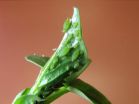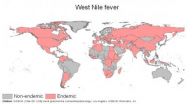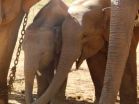(Press-News.org) You might not think much about pea aphids, but it turns out they've got skills enough to get aerospace engineers excited. A report in the February 4th issue of Current Biology, a Cell Press publication, shows that the insects can free fall from the plants they feed on and—within a fraction of a second—land on their feet every time. Oftentimes, the falling aphids manage to cling to a lower part of the plant by their sticky feet on the way down, avoiding the dangerous ground altogether.
That's despite the fact that most aphids in a colony are wingless and have no special body surfaces to turn themselves right-side up. Rather, high-speed video analysis shows that they hold their bodies and limbs in a special posture, which allows them to passively rotate and then stay in a back-up, feet-down position.
VIDEO:
You might not think much about pea aphids, but it turns out they’ve got skills enough to get aerospace engineers excited. A report in the Feb. 4th issue of Current...
Click here for more information.
"Animals are capable of performing remarkable tasks to maximize their chances of survival," said Gal Ribak from the Technion-Israel Institute of Technology's aerospace engineering department. "There is ample data on biochemical, physiological, and behavioral adaptations, but comparative biomechanics tells us that creatures exploit the laws of physics to their advantage just as well."
It was Moshe Gish and Moshe Inbar from the University of Haifa who first noticed the behavior. Gish was studying the aphid dropping behavior in response to the breath of mammalian herbivores when he noticed that, during the entire (very brief) descent of the insects, he only saw their backs. This suggested that the aphids almost always landed upright. To verify his suspicion, Gish dropped aphids on cardboard covered with a thin layer of red powder. Sure enough, almost all of the aphids showed a clear red spot on their abdomens.
VIDEO:
You might not think much about pea aphids, but it turns out they’ve got skills enough to get aerospace engineers excited. A report in the Feb. 4th issue of Current...
Click here for more information.
The researchers enlisted Ribak , a biomechanics researcher, and aerospace engineer Daniel Weihs to investigate further. After watching hundreds of movies starring the aphids and their natural ladybug (ladybird) predators, they determined that the aphids land on their feet 96 percent of the time.
"What puzzled us was that the aphids did not seem to do much in order to right themselves," Ribak said. "Their body posture remained fairly constant during the entire fall."
Mathematical models showed that the air resistance on the aphids' appendages rotates their bodies as they fall through air regardless of their starting orientation. "This is what aerodynamicists call 'static longitudinal stability,' one of the things that an aircraft engineer needs to think about when designing a plane," Ribak explained.
Those acrobatic feats are a matter of life and death for the aphids, added Gish. "Aphids that are confronted with an attacking predator are caught between the devil and the deep blue sea." If they stay put, they may be gobbled up by predators, and if they drop to the ground, they may get lost and starve to death or fall prey to someone else. Time to stop, drop, and roll.
INFORMATION:
Current Biology, Ribak et al.: "Adaptive Aerial Righting during the Escape Dropping of Wingless Pea Aphids."
The impressive aerial maneuvers of the pea aphid
2013-02-04
ELSE PRESS RELEASES FROM THIS DATE:
Avoiding a cartography catastrophe
2013-02-04
KNOXVILLE, TN – Since the mid-nineteenth century, maps have helped elucidate the deadly mysteries of diseases like cholera and yellow fever. Yet today's global mapping of infectious diseases is considerably unreliable and may do little to inform the control of potential outbreaks, according to a new systematic mapping review of all clinically important infectious diseases known to humans.
Of the 355 infectious diseases assessed in the review, 174 showed a strong rationale for mapping and less than 5 percent of those have been mapped reliably. Unreliable mapping makes it ...
AB blood type strong risk factor for venous blood clots
2013-02-04
The non-O ABO blood type is the most important risk factor for venous thromboembolism (blood clots in veins), making up 20% of attributable risk for the condition, according to a new study in CMAJ (Canadian Medical Association Journal).
This finding has implications for genetic screening for thrombophilia, a genetic predisposition to abnormal blood clotting.
Danish researchers looked at data on 66 001 people who had been followed for 33 years from 1977 through 2010 to determine whether ABO blood type is associated with an increased risk of venous blood clots in the ...
Tuberculosis in Nunavut can be controlled
2013-02-04
A combined strategy is needed to combat tuberculosis in Nunavut where the rate is 66 times higher than in the general Canadian population, states a commentary in CMAJ (Canadian Medical Association Journal).
Nunavut, Canada's eastern territory in the north, has seen a dramatic increase in the disease since 1997. Previous efforts to eradicate the disease focused on early identification and treatment of people as well as treatment of latent cases. This intense approach helped decrease the number of cases, but was not continued.
"Intensive control activities should be expanded ...
Physicians' roles on the front line of climate change
2013-02-04
Physicians can and should help mitigate the negative health effects of climate change because they will be at the forefront of responding to the effects of global warming, argues an editorial in CMAJ (Canadian Medical Association Journal).
Doctors could use their political influence to lobby government on climate issues that are already affecting health and to become signatories to the Doha Declaration on Climate, Health and Wellbeing.
They can also act at a professional level, by leading health institutions to cut back on greenhouse gases and reduce clinical waste.
"The ...
JoVE expands scientific video publication into chemistry
2013-02-04
February 4, 2013
Cambridge, MA: On Monday, February 4, 2013, JoVE (Journal of Visualized Experiments) will launch the first scholarly scientific video publication for chemistry. Following its successful introduction of video publications for the biological and physical sciences, JoVE received numerous requests for a chemistry counterpart. In response, the journal is launching a new section, JoVE Chemistry, dedicated to visualized publication of experiments across different areas of chemistry research including organic chemistry, chemical biology, electrochemistry, and ...
Pitt researchers reveal mechanism to halt cancer cell growth, discover potential therapy
2013-02-04
PITTSBURGH, Feb. 4, 2013 – University of Pittsburgh Cancer Institute (UPCI) researchers have uncovered a technique to halt the growth of cancer cells, a discovery that led them to a potential new anti-cancer therapy.
When deprived of a key protein, some cancer cells are unable to properly divide, a finding described in the cover story of the February issue of the Journal of Cell Science. This research is supported in part by a grant from the National Institutes of Health.
"This is the first time anyone has explained how altering this protein at a key stage in cell ...
Men are from Mars Earth, women are from Venus Earth
2013-02-04
For decades, popular writers have entertained readers with the premise that men and women are so psychologically dissimilar they could hail from entirely different planets. But a new study shows that it's time for the Mars/Venus theories about the sexes to come back to Earth.
From empathy and sexuality to science inclination and extroversion, statistical analysis of 122 different characteristics involving 13,301 individuals shows that men and women, by and large, do not fall into different groups. In other words, no matter how strange and inscrutable your partner may ...
Low rainfall and extreme temperatures double risk of baby elephant deaths
2013-02-04
Extremes of temperature and rainfall are affecting the survival of elephants working in timber camps in Myanmar and can double the risk of death in calves aged up to five, new research from the University of Sheffield has found.
With climate change models predicting higher temperatures and months without rainfall; this could decrease the populations of already endangered Asian elephants.
The researchers matched monthly climate records with data on birth and deaths, to track how climate variation affects the chances of elephant survival.
It is hoped this research ...
Your history may define your future: Tell your doctor
2013-02-04
Boston, MA—Your family history is important, not just because it shaped you into who you are today, but it also impacts your risk for developing cancer and other chronic diseases. For example, if one of your family members had cancer, your primary care doctor needs to know. Being able to identify individuals at increased risk can help reduce mortality. In a study published this week in the online version of the Journal of General Internal Medicine, researchers at Brigham and Women's Hospital (BWH) found that patients who use a web-based risk appraisal tool are more likely ...
Tropical rainfall patterns varied through time
2013-02-04
PITTSBURGH—Historic lake sediment dug up by University of Pittsburgh researchers reveals that oceanic influences on rainfall in Central America have varied over the last 2,000 years, highlighting the fluctuating influence the Atlantic and Pacific Oceans have on precipitation.
The Pitt study, published in the February print edition of the peer-reviewed journal Geology, shows that factors currently producing drier climates in Central America actually resulted in wetter conditions a few hundred years ago, providing a deeper understanding of drought cycles in that region ...




